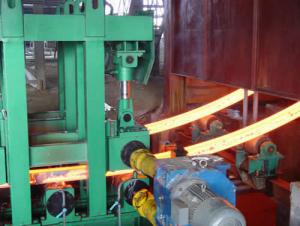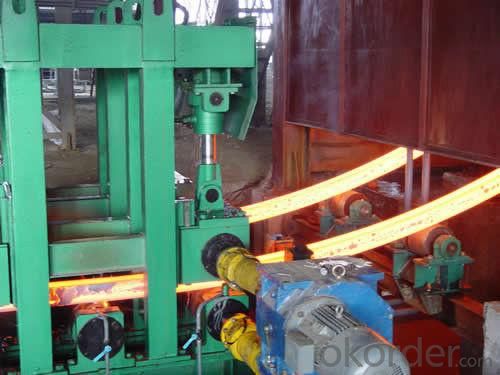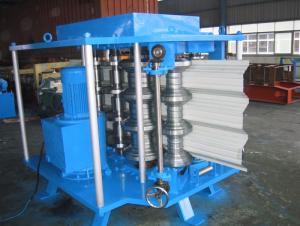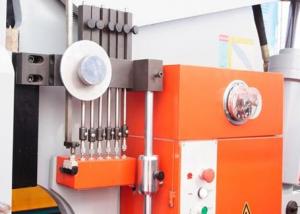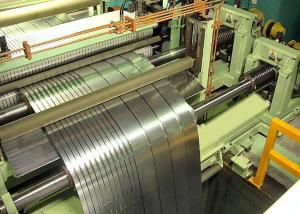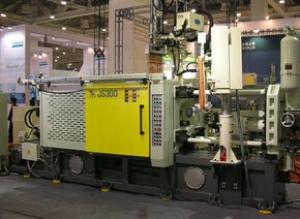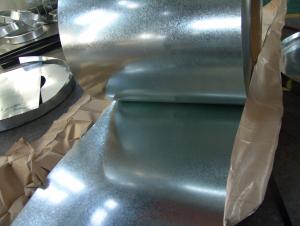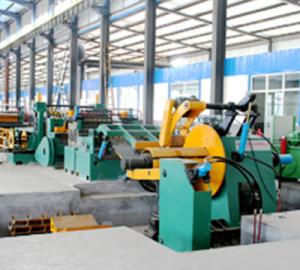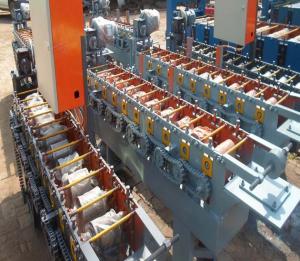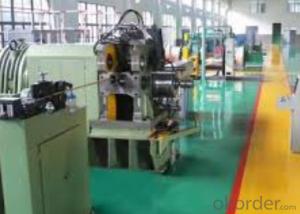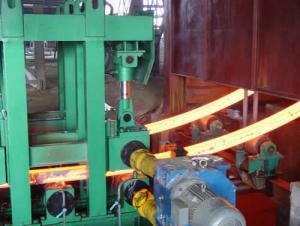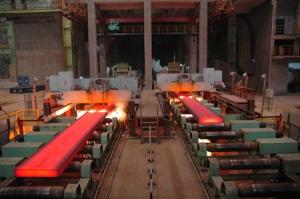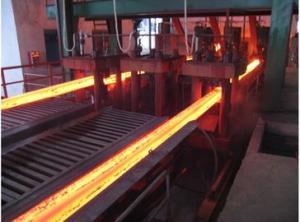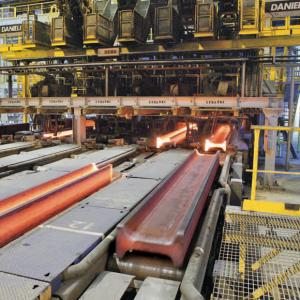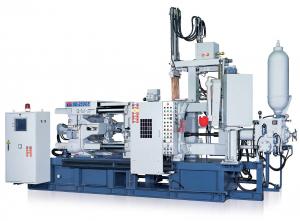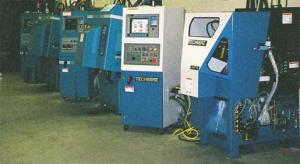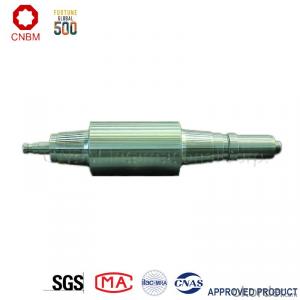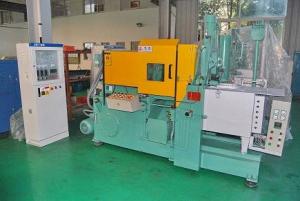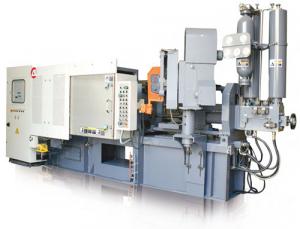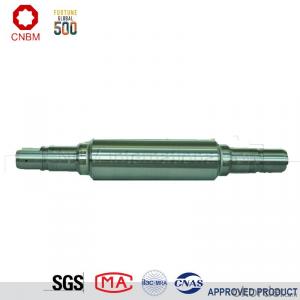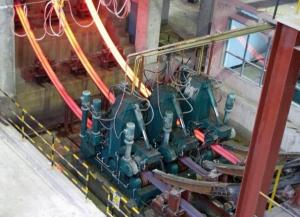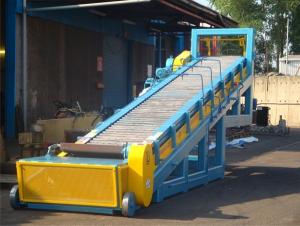Continuous Casting Machine
- Loading Port:
- China Main Port
- Payment Terms:
- TT or LC
- Min Order Qty:
- 1 Set set
- Supply Capability:
- 30 Sets Per Year set/month
OKorder Service Pledge
Quality Product, Order Online Tracking, Timely Delivery
OKorder Financial Service
Credit Rating, Credit Services, Credit Purchasing
You Might Also Like
Technology process:
1.Heat the EVA film
2.Cover the heated EVA film on the mould(can be made from wood or aluminum)
3.Spray a coating in a certain baume degree
4.Put on the empty blask
5.Sand-up the flask and vibrate to compaction
Packaging & Delivery
Packaging Details:containers
Delivery Detail:Complete one set of equipment needs for three months
- Q: How can robotics improve productivity in metal casting machinery?
- Automating various processes and tasks that were previously done manually, robotics has the potential to greatly enhance productivity in metal casting machinery. Efficiency and speed can be notably improved through the use of robots. They are able to perform repetitive tasks with precision and accuracy, resulting in faster cycle times and increased production rates. This eliminates the need for human operators to handle heavy or complex parts, reducing the risk of injuries and ensuring consistent quality. Furthermore, robots have the capability to handle multiple tasks simultaneously, enabling multitasking and continuous operation. They can carry out various tasks, including material handling, pouring molten metal, removing castings, and cleaning molds, all in a synchronized and efficient manner. This eliminates any downtime between tasks and minimizes the overall production time, ultimately leading to improved productivity. The overall quality of metal castings can also be enhanced through the use of robotic systems. By utilizing sensors and advanced vision systems, robots can guarantee that the molds are properly filled, thereby reducing the occurrence of defects and improving the overall yield. They can also conduct inspections and quality control checks during the production process, promptly identifying any faults or inconsistencies and preventing further waste or rework. Moreover, robotics offers flexibility and adaptability to accommodate changing production needs. With the utilization of programming and advanced software, robots can be easily reprogrammed and reconfigured to meet different product designs or casting requirements. This allows manufacturers to swiftly switch between various products or variations, reducing setup times and maximizing the utilization of machinery. In conclusion, the integration of robotics in metal casting machinery has the potential to significantly enhance productivity by improving efficiency, speed, and quality, while also providing flexibility and adaptability to meet the demands of modern manufacturing.
- Q: Can metal casting machinery be used for investment casting of shape memory alloys?
- Yes, metal casting machinery can be used for investment casting of shape memory alloys. Investment casting, also known as lost-wax casting, is a widely used method for producing complex metal parts with high dimensional accuracy. It involves creating a wax pattern that is coated with a ceramic shell, which is then heated to melt and remove the wax, leaving behind a cavity. Molten metal is then poured into the cavity and allowed to solidify before the ceramic shell is broken away to reveal the final part. Shape memory alloys, such as Nitinol, are a type of metallic material that exhibit unique properties, including the ability to return to their original shape after being deformed. These alloys are often used in various industries, such as aerospace, medical, and automotive, due to their shape memory and superelasticity characteristics. Metal casting machinery can certainly be used for investment casting of shape memory alloys. The process of investment casting allows for the production of intricate shapes and complex geometries, making it suitable for shape memory alloy parts that require high precision and intricate features. The machinery used for investment casting can handle the melting and pouring of shape memory alloys, ensuring that the molten metal is properly cast into the ceramic shell and solidifies to form the desired shape. However, it is important to note that the casting parameters may need to be adjusted to accommodate the specific characteristics of shape memory alloys. These alloys have unique thermal and mechanical properties, which can affect the casting process. It may be necessary to control the cooling rate, preheat the mold, or use specific pouring techniques to ensure proper solidification and retain the desired shape memory properties of the alloy. In conclusion, metal casting machinery can be effectively used for investment casting of shape memory alloys. This process allows for the production of complex and precise parts, making it suitable for the manufacturing of shape memory alloy components in various industries. However, careful consideration and potential adjustments to the casting parameters may be required to account for the unique properties of shape memory alloys.
- Q: How is the casting assembled and joined with other components in metal casting machinery?
- In metal casting machinery, the casting is assembled and joined with other components through various methods. One common method is by fastening or bolting the casting to other parts using screws, nuts, or bolts. Welding is another popular technique, where the casting is joined to other components by melting and fusing the metal together. Adhesive bonding can also be used, where a strong adhesive is applied between the casting and other parts to create a secure bond. Additionally, mechanical methods such as press-fitting or interference fitting can be employed to assemble and join the casting with other components, ensuring a tight and stable connection.
- Q: Can metal casting machinery be used for producing castings with uniform properties?
- Metal casting machinery offers the capability to produce castings with consistent and uniform properties. The machinery grants precise control over various factors, including temperature, pressure, and cooling rates, which are crucial for achieving uniform properties in castings. By regulating the temperature, the metal can be melted to the desired consistency and viscosity, guaranteeing even flow into the mold. This helps avoid problems like cold shuts or porosity, which can lead to uneven properties. Furthermore, the machinery permits controlled pressure application throughout the casting process. This pressure aids in expelling any trapped air or gas from the mold, ensuring the metal fills all intricate details of the mold, resulting in uniform properties. In addition, metal casting machinery allows for the implementation of controlled cooling rates. By managing the cooling process, defects such as shrinkage or cracks, which can cause non-uniform properties in castings, can be prevented. Moreover, the use of advanced technologies in metal casting machinery, such as computer-aided design (CAD) and simulation software, facilitates precise modeling and optimization of the casting process. This aids in predicting potential defects and optimizing parameters to achieve uniform properties in the final castings. In summary, through proper utilization and control of metal casting machinery, it is feasible to produce castings with uniform properties that meet desired specifications and quality standards.
- Q: How is the mold cavity vented in metal casting machinery?
- In metal casting machinery, the mold cavity is vented to allow for the escape of gases and air that may be trapped during the casting process. This is important because if these gases are not adequately vented, they can cause defects in the final product. There are several methods used to vent the mold cavity in metal casting machinery. One common technique is to use vent pins or vent tubes. These are small, thin rods or tubes that are inserted into the mold cavity. They are strategically placed to allow for the release of gases and air as the molten metal is poured into the mold. Another method is the use of venting channels or slots. These are narrow grooves or channels that are machined into the mold cavity. These channels provide a pathway for the gases and air to escape. Additionally, some molds may have venting inserts or inserts with venting grooves. These inserts are placed in the mold cavity and are designed to provide additional venting capabilities. The choice of venting method depends on factors such as the complexity of the mold design, the size of the casting, and the type of metal being used. It is important to carefully consider the venting requirements for each specific casting to ensure that the mold cavity is properly vented and the final product is free from defects.
- Q: How does die casting machinery differ from other metal casting machinery?
- Die casting machinery differs from other metal casting machinery in a few key ways. Firstly, die casting machinery is specifically designed for high-pressure casting, whereas other metal casting machinery may be used for a variety of casting processes including sand casting, investment casting, or gravity casting. Die casting involves injecting molten metal into a mold cavity at high speeds and pressures, resulting in a more precise and accurate casting with excellent surface finish. Secondly, die casting machinery is typically automated or semi-automated, making it more efficient and productive compared to other metal casting machinery. The entire die casting process, from molten metal injection to solidification and ejection of the cast part, can be controlled and monitored by computerized systems, reducing the need for manual intervention and minimizing human error. Thirdly, die casting machinery is usually equipped with a two-part mold, known as a die, which is made of hardened steel. The die is precision-machined to create the desired shape and features of the cast part. This reusable die allows for high-volume production and consistency in part dimensions and quality. In contrast, other metal casting machinery often uses expendable molds made of sand, plaster, or ceramic, which need to be replaced after each casting. Lastly, die casting machinery is capable of producing complex and intricate parts with thin walls and tight tolerances. The high-pressure casting process ensures that the molten metal fills the mold completely, capturing all the intricate details of the part design. This makes die casting suitable for manufacturing parts with complex geometries, such as engine components, automotive parts, electronics housings, and consumer products. Overall, die casting machinery offers distinct advantages in terms of precision, efficiency, and complexity compared to other metal casting machinery, making it a preferred choice for many industrial applications.
- Q: How do you ensure compliance with safety guidelines and protect operators from hazards?
- To ensure compliance with safety guidelines and protect operators from hazards, it is crucial to establish and enforce a comprehensive safety program. This includes conducting regular safety training sessions to educate operators about potential hazards and the necessary safety measures to mitigate them. Additionally, implementing routine inspections and audits can help identify any safety gaps and address them promptly. Providing operators with appropriate personal protective equipment (PPE) and ensuring its proper use is also essential. Regular communication and feedback channels should be established to encourage operators to report any safety concerns or incidents promptly. By consistently reinforcing safety protocols and fostering a safety-conscious culture, compliance with safety guidelines can be ensured, and operators can be effectively protected from hazards.
- Q: What are the considerations for trimming and finishing processes in metal casting machinery?
- Trimming and finishing processes in metal casting machinery necessitate several crucial factors to be taken into account. To begin with, the type of metal used for the casting is a key consideration. Different metals possess varying levels of hardness and characteristics that can impact the trimming and finishing procedures. For example, softer metals may require less aggressive trimming techniques, whereas harder metals may necessitate specialized tools or processes. The complexity of the casting design is another factor to be considered. Intricate or complex castings may call for more precise trimming and finishing techniques to achieve the desired final shape and surface finish. This may involve the utilization of specialized cutting tools, grinding machines, or even manual hand-finishing methods. The desired surface finish of the casting is yet another important consideration. Depending on the intended application or aesthetic requirements, the casting may need to have a smooth, polished, or textured surface. This can influence the selection of finishing processes such as sanding, buffing, or shot blasting, as well as the choice of appropriate abrasives or media. Moreover, the size and weight of the casting can impact the trimming and finishing processes. Handling and maneuvering large or heavy castings during these operations may necessitate specialized equipment like overhead cranes or lifting devices to ensure safety. The volume and production rate of castings also have an influence on the choice of trimming and finishing processes. High-volume production may require automated or mechanized equipment to ensure efficiency and consistency, while low-volume or custom productions may allow for more manual or artisanal techniques. Lastly, cost considerations play a significant role in selecting trimming and finishing processes. Some processes may be more time-consuming, labor-intensive, or require specialized equipment, thereby increasing overall production costs. Therefore, it is crucial to evaluate the trade-offs between desired quality, efficiency, and cost-effectiveness when determining the optimal trimming and finishing processes for metal casting machinery.
- Q: How is the quality of the final product ensured in metal casting machinery?
- The quality of the final product in metal casting machinery is ensured through a combination of rigorous quality control measures. These measures include conducting thorough inspections of the raw materials, monitoring and controlling the casting process parameters such as temperature and pressure, using advanced testing techniques such as non-destructive testing to identify any defects or irregularities, and conducting final inspections to ensure that the product meets all the required specifications and standards. Additionally, continuous improvements in the design and manufacturing processes, as well as regular maintenance and calibration of the machinery, also contribute to ensuring the quality of the final product.
- Q: What are the different types of documentation and traceability systems used with metal casting machinery?
- To ensure the quality and integrity of the metal casting process, various documentation and traceability systems are utilized. These systems are responsible for tracking and recording crucial information related to raw materials, manufacturing procedures, and the final product. The different types of documentation and traceability systems employed in metal casting machinery are as follows: 1. Material Certification: This involves documenting the properties and composition of the raw materials used. Certificates of analysis (COA) provide details about the chemical composition, mechanical properties, and other relevant information of the materials. 2. Process Documentation: This entails documenting the different steps and procedures involved in the casting process. Work instructions, process control plans, and standard operating procedures (SOPs) outline the specific requirements and guidelines for each stage of the process. 3. Inspection Records: This involves documenting the results of inspections and tests conducted during the casting process. Inspection reports, non-destructive testing (NDT) results, and quality control checks ensure that the casting meets the necessary specifications and standards. 4. Traceability Systems: These systems facilitate the tracking and identification of each casting throughout the manufacturing process. Unique identification codes or serial numbers are used to trace the casting from raw material procurement to final delivery. This enables easy identification and retrieval of specific castings in the event of quality issues or recalls. 5. Quality Management Systems: These systems ensure the overall quality and consistency of the casting process. They encompass quality control plans, quality assurance procedures, and documentation of corrective actions taken to address any quality deviations or non-conformities. 6. Certifications and Compliance: Metal casting machinery may require specific certifications or compliance with industry standards. Documentation related to these certifications, such as ISO 9001 or ASTM standards, guarantees that the casting process meets the necessary quality and safety standards. In conclusion, these documentation and traceability systems are vital for maintaining the quality, conformity, and traceability of metal castings. They enable manufacturers to uphold consistent quality and provide customers with the essential information and assurance regarding the product they receive.
Our professions include metallurgical technology, equipment and automation. We can provide the best solutions to the production process, design & manufacture of equipment and electrical automation regarding various industries in domestic and foreign districts with exquisite technology and fine quality service. We can provide all-around services to customers from development & design to the provision, installation and running of products.Strong technical strength, advanced equipment manufacturing technology, fine quality professional talents, and perfect service systems all bring about reliability, relaxation, convenience and delight to the cooperation with customers from beginning to end.
1. Manufacturer Overview
| Location | Jiangsu,China (Mainland) |
| Year Established | 2000 |
| Annual Output Value | |
| Main Markets | South America Eastern Europe Southeast Asia Africa Mid East South Asia Domestic Market |
| Company Certifications |
2. Manufacturer Certificates
| a) Certification Name | |
| Range | |
| Reference | |
| Validity Period |
3. Manufacturer Capability
| a) Trade Capacity | |
| Nearest Port | SHANGHAI |
| Export Percentage | 21% - 30% |
| No.of Employees in Trade Department | 3-5 People |
| Language Spoken: | English, Chinese |
| b) Factory Information | |
| Factory Size: | |
| No. of Production Lines | |
| Contract Manufacturing | |
| Product Price Range | |
Send your message to us
Continuous Casting Machine
- Loading Port:
- China Main Port
- Payment Terms:
- TT or LC
- Min Order Qty:
- 1 Set set
- Supply Capability:
- 30 Sets Per Year set/month
OKorder Service Pledge
Quality Product, Order Online Tracking, Timely Delivery
OKorder Financial Service
Credit Rating, Credit Services, Credit Purchasing
Similar products
Hot products
Hot Searches
